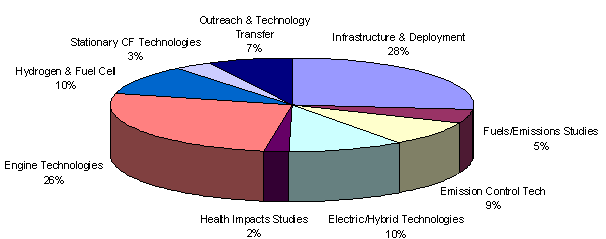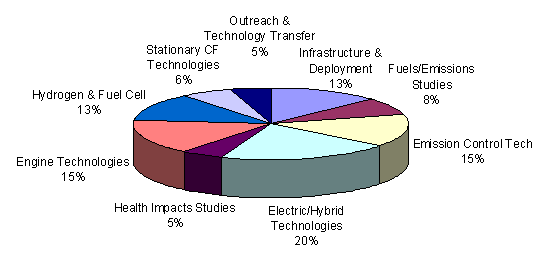A large number of emission sources contribute to the remaining air quality problems in Southern California. Given the diversity of these sources, it is unlikely that a single technology will solve these problems. As a result, the South Coast AQMD continues to support a wide range of advanced technologies to address this diversity. The Clean Fuels Program plays a major role in the advancement of those technologies through research, development, demonstration, and deployment (RDD&D). Projects co-funded by the South Coast AQMD’s Clean Fuels Program have included emission reduction demonstrations for both mobile and stationary sources of air pollution.
Historically, mobile source projects have targeted low-emission technology developments in automobiles, transit buses, medium- and heavy-duty trucks, and off-road applications. These vehicle-related efforts have focused on advancements in engine design, electric power trains, and energy storage/conversion devices (e.g., fuel cells and batteries); and implementation of clean fuels (e.g. natural gas, propane, and hydrogen), including their infrastructures. Stationary source projects have included a wide array of advanced low NOx technologies, low VOC coatings and processes, and clean energy alternatives, such as fuel cells, solar power, and other renewable energy systems.
The South Coast AQMD continually seeks to support the deployment of lower emitting technologies. The design and implementation of the Clean Fuels Program Plan must balance the needs in the various technology sectors with technology readiness, emissions reduction potential and co-funding opportunity. South Coast AQMD strives to maintain a flexible program to address dynamically evolving technologies and the latest progress in the state-of-the-technology. South Coast AQMD’s effort in this area is shaped by two basic factors:
-
Low- and zero-emission technologies needed to achieve clean air standards in the Basin.
-
Available funding to support technology development within the constraints imposed by that funding.
This effort is significant, especially during these economically tough times when both public and private funding available for technology research and development are limited. However, since national and international activities affect the direction of technology trends, our real challenge is to identify project or technology opportunities in which available funding can make a significant difference in deploying progressively cleaner technologies in the South Coast Air Basin. As a result, the South Coast AQMD program must be flexible to accommodate these changes in direction.
The overall strategy is based in large part on technology needs identified in the Air Quality Management Plan (AQMP) and the South Coast AQMD Governing Board’s directives to protect the health of residents in the Basin. The AQMP is the long-term “blueprint” that defines:
-
the basin-wide emission reductions needed to achieve federal ambient air quality standards;
-
the regulatory measures to achieve those reductions;
-
the timeframes to implement these proposed measures; and
-
the technologies required to meet these future proposed regulations.
Specific projects are selected for co-funding from competitive solicitations, cooperative agency agreements, and unsolicited proposals. Criteria considered in project selection include emissions reduction potential, technological innovation, potential to reduce costs and improve cost effectiveness, contractor experience and capabilities, overall environmental impact or benefit, commercialization and business development potential, cost sharing, and consistency with program goals and funding constraints.
During calendar year 2012, the Governing Board approved 69 new projects or studies and modified 10 continuing projects adding additional dollars toward RDD&D of alternative fuel and clean fuel technologies in Southern California. During 2012, the South Coast AQMD supported a variety of projects and technologies, ranging from near-term to longer-term research, development, demonstration and deployment activities. This “technology portfolio” strategy provides the South Coast AQMD the ability and flexibility to leverage state and federal funding while also addressing the specific needs of the South Coast Air Basin.
Projects in 2012 included continued expansion of natural gas alternative refueling infrastructure and vehicle deployment; development and demonstration of hydrogen technologies and infrastructure; further development and demonstration of plug-in hybrid and battery electric vehicle technologies and infrastructure with an emphasis on zero-emission goods movement technologies; continued demonstration of emission control technologies on heavy-duty trucks to reduce NOx and PM; health impact studies ranging from effects of PM particles from heavy-duty biodiesel-fueled vehicles to physical and chemical composition of and health effects from tailpipe PM emissions; and finally two stationary clean fuels projects including one to develop and demonstrate a 300 kW molten fuel cell that works in conjunction with an exhaust-fired absorption chiller.
South Coast AQMD contributed approximately $6.1 million in partnership with other governmental organizations, private industry, academia and research institutes, and interested parties, with total project costs of nearly $26.1 million. These projects or studies addressed a wide range of air quality issues with a diverse mix of advanced technologies. The pie chart below shows the distribution of the Clean Fuels Program funds approved by the Governing Board in 2012.

Distribution of Funds for Executed Clean Fuels Projects CY 2012 ($6.1 million)
In addition to the new projects, 20 research, development, and demonstration projects or studies and 20 technology assessment and transfer contracts were completed in CY 2012. The project summaries are provided to the Governing Board Technology Committee during the year as the projects are completed. Summaries for each of these projects are provided in Appendix C of the Annual Report.
The figure below shows the potential 2013 distribution of South Coast AQMD Clean Fuels funds, based on projected program costs of $16.2 million for the nine primary project areas. The expected actual project expenditures for 2013 will be much less than the total projected program cost since not all projects will materialize. The target allocations are based on balancing technology priorities, technical challenges and opportunities discussed previously, and near-term versus long-term benefits with the constraints based on available South Coast AQMD funding. Specific contract awards throughout 2013 will be based on this proposed allocation, the quality of proposals received and evaluation of projects against standardized criteria, and, ultimately, the Governing Board’s approval. Upon presentation to the Governing Board for project approval, additional details will be provided about the technology, its application, the specific scope of work, the project team capabilities, and the project cost-sharing.

Projected Cost Distribution for Potential Projects in 2013 ($16.2 Million)